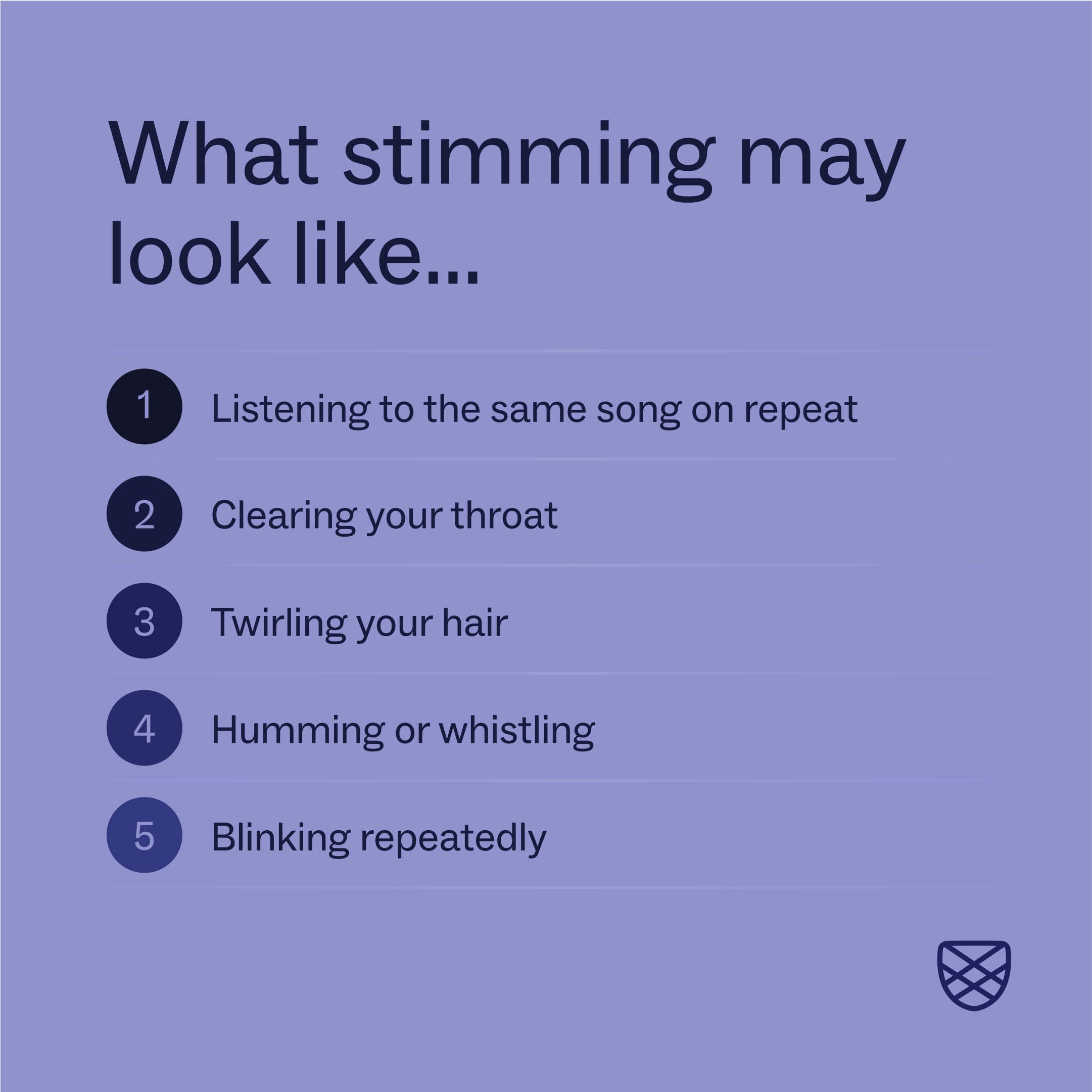
Table of Contents
What is Stimming? Understanding the Connection With ADHD and Autism

Written By: Dr. Rasna Kaur Neelam

Clinically Reviewed By: Dr. Don Gasparini
July 17, 2023
6 min.
Stimming is a type of self-stimulatory behavior— like blinking, rocking back and forth, or picking at scabs—that people do to self-soothe. Anyone can stim, but stimming is commonly linked with neurodivergence, ADHD, and autism. In this article, we discuss stimming and learn more about the benefits, stigmas, and misconceptions.
Learn more about our Clinical Review Process
Table of Contents
Introducing stimming
Stimming is a self-stimulatory behavior meaning, as its name suggests, a behavior that people can do to stimulate themselves. Examples of stimming might include whistling, cracking your knuckles, or drawing shapes with your eyes. Through self-stimulation, or stimming, individuals may attempt to reduce anxiety, block out stimulus from the outside world, or combat other negative emotions.

Struggling with ADHD?
Charlie Health has personalized treatment for you.
What does stimming look like?
Self-stimulation comes in numerous forms. Often the individual who is stimming does not realize they are doing these actions. Below are a few examples. As you’re reading this list, please note that some forms of self-stimulation may be healthy, with no consequences, while others are not.
- Stimming through sight: aligning books or other household objects by color, size, or shape, focusing and unfocusing the eyes, watching pleasing videos, staring at lights
- Stimming through touch: picking at scabs, twirling hair, cracking knuckles, picking at nails, clenching fists, grinding teeth, petting an animal or another soft item, braiding hair, pulling out hair, opening and closing a door
- Stimming through smell: smelling a particular scent or perfume, smelling freshly washed clothing, smelling food, smelling essential oils
- Stimming through sound: listening to sounds or songs repeatedly, listening to household appliances, listening to sounds in nature
- Stimming through speech: humming, repeating sounds, whistling, clearing one’s throat, click their tongue, yelling, grunting
- Stimming through bodily movement: rocking back and forth, shrugging shoulders, jumping up and down, shaking or flapping different body parts, spinning in a circle, hitting body parts against a wall or object
- Stimming through multiple senses: creating art or doodling, putting together puzzles, playing an instrument, shuffling cards
Above are some examples of stimming, however many additional examples exist.

Who participates in stimming?
Any individual may find themselves self-stimulating by performing one of the actions listed above (or by performing an action not listed).
Recently, however, self-stimulation has gained more attention as it relates to individuals who are neurodivergent. Neurodivergence is a term to define an individual whose brain may work differently than the “norm” or majority of individuals. Two of the most common conditions that fall under the category of neurodivergence are attention-deficit/hyperactivity disorder (ADHD) and autism spectrum disorder. Here’s how these two conditions are defined:
- ADHD: a neurodevelopmental disorder that is commonly diagnosed in childhood or early adulthood. Individuals with ADHD have trouble paying attention or controlling compulsive behavior.
- Autism spectrum disorder: a developmental disability characterized by difficulties in communication and interaction and restrictive or repetitive behaviors and interests. Additionally, people with autism may have delayed movement and cognitive skills, different eating or sleeping disorders, and a variety of mood or mental health disorders.
To be clear, participating in self-stimulation does not make you neurodivergent or mean that you have ADHD or autism. On the flip side, not all individuals who have ADHD or autism stim. For more information about a clinical diagnosis, please seek testing with a trained clinician.

Why do people stim?
There are many reasons why people might stim, here are some of the most common:
Boredom
Individuals who are neurodivergent may have difficulty focusing or paying attention and may use stimming as a way to focus or pass the time. For example, researchers have found that individuals with ADHD have low levels of dopamine, a reward drug, in their system. This leads them to seek feelings or drugs that increase dopamine or provide stimulus. Self-stimulation allows these people to combat periods of boredom by providing a stimulus or task on which to focus.
Self-soothing
Stimming can act as a coping mechanism for individuals who are in a high stress environment. For example, if an individual with ADHD or autism is in a busy restaurant with a lot of stimuli, performing a repetitive, known action such as tapping a foot gives them a predictable stimulus to focus on instead of becoming overwhelmed by unpredictable chatter, sounds, and energy.
Other times, stimming could be a coping mechanism for pain or a health condition. For example, a non-verbal individual may bang their head against a wall if they experience migraines and are unable to communicate their pain. For this reason, it is important to consult a medical professional when it comes to stims that are self-harming or may represent an underlying illness.
Releasing energy
Feelings of restlessness, anxiety, or stress impact us all. But these sensations can be heightened in neurodiverse individuals. Self-stimulation can be a way to release pent-up energy and feel more calm.
Benefits and risks
As mentioned above, stimming allows individuals to self-soothe, release anxiety, process emotions, concentrate, and fight boredom. However, not all stimming is always positive.
Some stimming behaviors can be unhealthy—physically or emotionally. Examples of these unhealthy stimming behaviors include pulling out hair, biting oneself, banging body parts against a wall, yelling to the point of voice hoarseness, cutting oneself, and more. If stimming behaviors are causing you harm, it’s important to think about healthier redirections.
Other stimming behaviors may not be unhealthy, but can invite unwanted attention. For example, if an individual’s stimming involves arm flapping, blinking, or spinning, it may invite bullying in school or make others in close vicinity feel uncomfortable.
If an individual who is stimming is not bothered by their own behaviors (and the behavior is not harmful), there is no “need” to modify behavior just to fit in. However, if an individual is being bullied or would like to make changes of their own volition, therapy, and training exercises at home can certainly help.
How can I redirect unhealthy stimming?
If you feel that your stimming is unhealthy or unwanted, try taking the following actions:
- Identify your triggers: Are there certain locations, situations, or people that trigger feelings of anxiety, boredom, or stress? Which of these triggers are avoidable, and which are not?
- Find alternative methods of self-stimulation: If self-stimulation helps to calm nerves and fight boredom, try alternative self-stimulation methods that are healthy for you and those around you.
- Discuss self-stimulation with those around you: Helping to educate family and friends around you on self-stimulation can help your loved ones better understand you.
- Be gentle with yourself: You do not need to be an expert on stimming! Many individuals do not even realize they are participating in these actions. Be kind to yourself in the same way you would be kind to a friend.
How can you support someone around you who stims?
If you are a parent or loved one who is trying to support someone who stims or trying to redirect unhealthy stimming, try doing the following:
- Create a sensory and emotional environment that is not triggering to your loved one.
- Set up a medical appointment for your loved one to make sure they are healthy and do not have underlying health conditions that could be causing or triggering stimming.
- Continue to engage or talk with your loved one while they stim instead of trying to actively stop them.
- Try to remain patient and empathetic with your loved one, even if they behave or think differently than you do.
- Redirect unhealthy stimming into activities that generate positive, healthy energy like exercise.
- Find a therapist that specializes in self-stimulatory behavior or works with neurodivergent clients. Sometimes therapy and, at times, medication can be useful in redirecting harmful self-stimulatory behavior toward behavior that is more healthy.
Treatment for stimming at Charlie Health
At Charlie Health, our specialists have experience working with individuals from all backgrounds, including people who are neurodivergent. In addition to one-on-one therapy, Charlie Health offers group sessions for your teen to work alongside others to manage their emotional and behavioral symptoms, including stimming. Get started today.




